View in other NatureServe Network Field Guides
NatureServe
Montana
Utah
Wyoming
Idaho
Wisconsin
British Columbia
South Carolina
Yukon
California
New York
Whitestem Goldenbush - Ericameria discoidea var. discoidea
Other Names:
Haplopappus macronema var. macronema
State Rank Reason (see State Rank above)
Rare in Montana where it is only known from a couple of sites in the southwest corner of the state. Population levels are poorly documented. One site is relatively inaccessible and not likely to be threatened by human impacts.
- Details on Status Ranking and Review
Population Size
Score3 - Vey Small: Generally <2,000 individuals.
Range Extent
Score1 - Peripheral, Disjunct or Sporadic Distribution in MT: Widespread species that is peripheral, disjunct or sporadically distributed within MT such that it occurs in <5% of the state (<7,500 sq. miles or the combined area of Beaverhead and Ravalli Counties) or is restricted to 4-5 sub-basins.
Area of Occupancy
Score3 - Very Low: Generally occurring in 3 or fewer Subwatersheds (6th Code HUC’s).
Environmental Specificity
Score1 - Moderate: Species is restricted to a specific habitat that is more widely distributed or to several restricted habitats and is typically dependent upon relatively unaltered, good-quality habitat (C Values of 5-7).
Trends
ScoreNA - Rank factor not assessed.
Threats
Score0-1 - Low to Medium.
Intrinsic Vulnerability
Score1 - Moderate Vulnerability: Specific biological attributes, unusual life history characteristics or limited reproductive potential makes the species susceptible to extirpation from stochastic events or other adverse impacts to its habitat and slow to recover.
Raw Conservation Status Score
Score
9 to 10 total points scored out of a possible 16 (Rarity factors and threats only).
General Description
Discoid Goldenweed is a low, rounded shrub with leafy stems that are 15-40 cm tall. Leaves are lance-shaped, widest above the middle, 1-3 cm long, and wavy-margined. The leaves and the inflorescence are glandular, the while stem is densely white-hairy. Flowering heads are borne in clusters of 1-3 at the ends of the branches. The glandular-hairy involucral bracts are 8-15 mm long, and the outer are broader and more leafy than the inner. Ray flowers are lacking. The 10-25 disk flowers are yellow and 8-11 mm long. The achenes have numerous, fine bristles on top.
Phenology
Flowering occurs in late July-August.
Diagnostic Characteristics
Few other Montana shrubs in the Aster family have stems that are covered with white, felt-like hair. Chrysothamnus parryi and C. nauseosus (rabbitbrush) usually have fewer than 12 flowers per head and the involucral bracts are arranged in well-defined vertical rows instead of overlapping like shingles as in Haplopappus. The other variety of this species in Montana, Haplopappus macronema var. linearis, has narrower leaves that are 8-20 times as long as wide and lack wavy margins.
Species Range
Montana Range
Range Descriptions
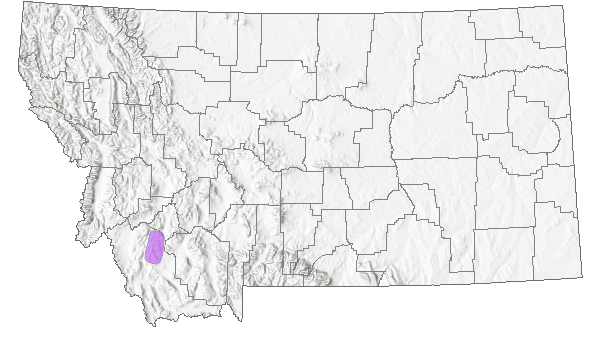
 Native
Native
Range Comments
The range of this variety is from se. OR to sw. MT, south to CA and UT. The range of this species as a whole is c. ID, sw MT, south to CA, UT, and CO. Peripheral.
Observations in Montana Natural Heritage Program Database
Number of Observations: 2
(Click on the following maps and charts to see full sized version)
Map Help and Descriptions
Relative Density
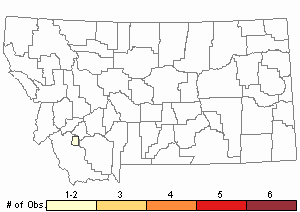
Recency
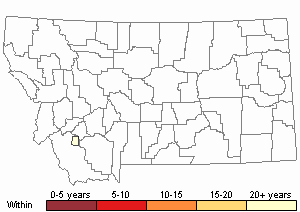

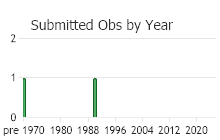
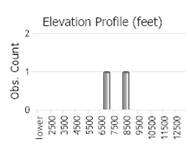 (Observations spanning multiple months or years are excluded from time charts)
(Observations spanning multiple months or years are excluded from time charts)
Habitat
Haplopappus macronema var. macronema grows in rocky, open, sparsely wooded slopes or coarse talus near or above treeline. In the Pioneer Mountains, it grows at about 7600 feet on a south-facing talus slope with scattered whitebark pine, sagebrush, delphinium and gooseberry.
Ecological Systems Associated with this Species
- Commonly Associated with these Ecological Systems
Forest and Woodland Systems
Shrubland, Steppe and Savanna Systems
Sparse and Barren Systems
Ecology
Plants of discoid goldenweed grow in partial shade but are usually associated with sparse vegetation. Seedlings may not be able to establish in dense vegetation.
POLLINATORS The following animal species have been reported as pollinators of this plant species or its genus where their geographic ranges overlap:
Bombus bifarius,
Bombus centralis,
Bombus huntii, and
Bombus melanopygus (Williams et al. 2014).
Management
There are no documented threats to the population in the Pioneer Mountains.
Stewardship Responsibility
Threats or Limiting Factors
STATE THREAT SCORE REASON
Threat impact not assigned because threats are not known (MTNHP Threat Assessment 2021).
References
- Literature Cited AboveLegend:
 View Online Publication
View Online Publication MTNHP Threat Assessment. 2021. State Threat Score Assignment and Assessment of Reported Threats from 2006 to 2021 for State-listed Vascular Plants. Botany Program, Montana Natural Heritage Program, Helena, Montana.
MTNHP Threat Assessment. 2021. State Threat Score Assignment and Assessment of Reported Threats from 2006 to 2021 for State-listed Vascular Plants. Botany Program, Montana Natural Heritage Program, Helena, Montana. Williams, P., R. Thorp, L. Richardson, and S. Colla. 2014. Bumble Bees of North America. Princeton, NJ: Princeton University Press. 208 p.
Williams, P., R. Thorp, L. Richardson, and S. Colla. 2014. Bumble Bees of North America. Princeton, NJ: Princeton University Press. 208 p.
- Additional ReferencesLegend:
 View Online Publication
View Online Publication
Do you know of a citation we're missing? Hall, H.M. 1928. The genus Haplopappus, a phylogenetic study in the compositae. Carnegie Institution of Washington Publication No. 389, Washington D.C. 391 pp.
Hall, H.M. 1928. The genus Haplopappus, a phylogenetic study in the compositae. Carnegie Institution of Washington Publication No. 389, Washington D.C. 391 pp. Lesica, P. 1992. Vascular plant and sensitive plant species inventory for the Highland Mountains, Deerlodge National Forest. Unpublished report prepared for the Deerlodge National Forest. Montana Natural Heritage Program, Helena, MT. 21 pp. plus appendices, photographs.
Lesica, P. 1992. Vascular plant and sensitive plant species inventory for the Highland Mountains, Deerlodge National Forest. Unpublished report prepared for the Deerlodge National Forest. Montana Natural Heritage Program, Helena, MT. 21 pp. plus appendices, photographs. Lesica, P. 1994. Sensitive plant survey of BLM lands along the Big Hole River and in the Whitehall Valley. Montana Natural Heritage Program, Helena, MT. 13 pp.
Lesica, P. 1994. Sensitive plant survey of BLM lands along the Big Hole River and in the Whitehall Valley. Montana Natural Heritage Program, Helena, MT. 13 pp. Lesica, P., M.T. Lavin, and P.F. Stickney. 2012. Manual of Montana Vascular Plants. Fort Worth, TX: BRIT Press. viii + 771 p.
Lesica, P., M.T. Lavin, and P.F. Stickney. 2012. Manual of Montana Vascular Plants. Fort Worth, TX: BRIT Press. viii + 771 p. Lesica, P., M.T. Lavin, and P.F. Stickney. 2022. Manual of Montana Vascular Plants, Second Edition. Fort Worth, TX: BRIT Press. viii + 779 p.
Lesica, P., M.T. Lavin, and P.F. Stickney. 2022. Manual of Montana Vascular Plants, Second Edition. Fort Worth, TX: BRIT Press. viii + 779 p. Schassberger, L.A. 1991. Rare plant inventory of the East Pioneer Mountains. Prepared for the USDA Forest Service, Region 1, Beaverhead National Forest. Montana Natural Heritage Program, Helena, MT. 55 pp.
Schassberger, L.A. 1991. Rare plant inventory of the East Pioneer Mountains. Prepared for the USDA Forest Service, Region 1, Beaverhead National Forest. Montana Natural Heritage Program, Helena, MT. 55 pp. Vanderhorst, J.P. and P. Lesica. 1995a. Sensitive plant survey of the Tendoy Mountains in the Beaverhead National Forest, Beaverhead County, Montana. Unpublished report to the Bureau of Land Management, Butte District. Montana Natural Heritage Program, Helena, MT. 59 pp. plus appendices.
Vanderhorst, J.P. and P. Lesica. 1995a. Sensitive plant survey of the Tendoy Mountains in the Beaverhead National Forest, Beaverhead County, Montana. Unpublished report to the Bureau of Land Management, Butte District. Montana Natural Heritage Program, Helena, MT. 59 pp. plus appendices.
- Web Search Engines for Articles on "Whitestem Goldenbush"





